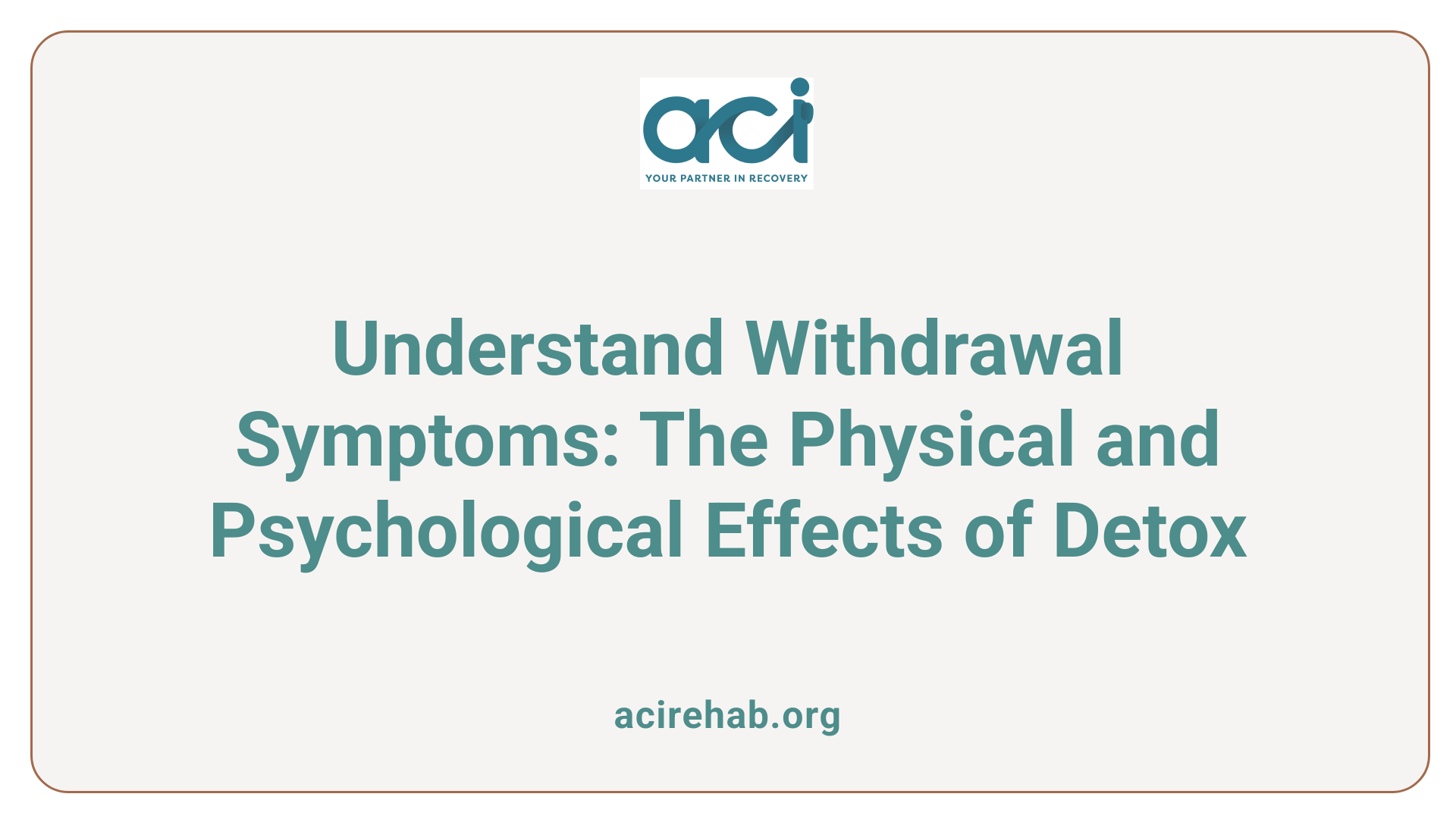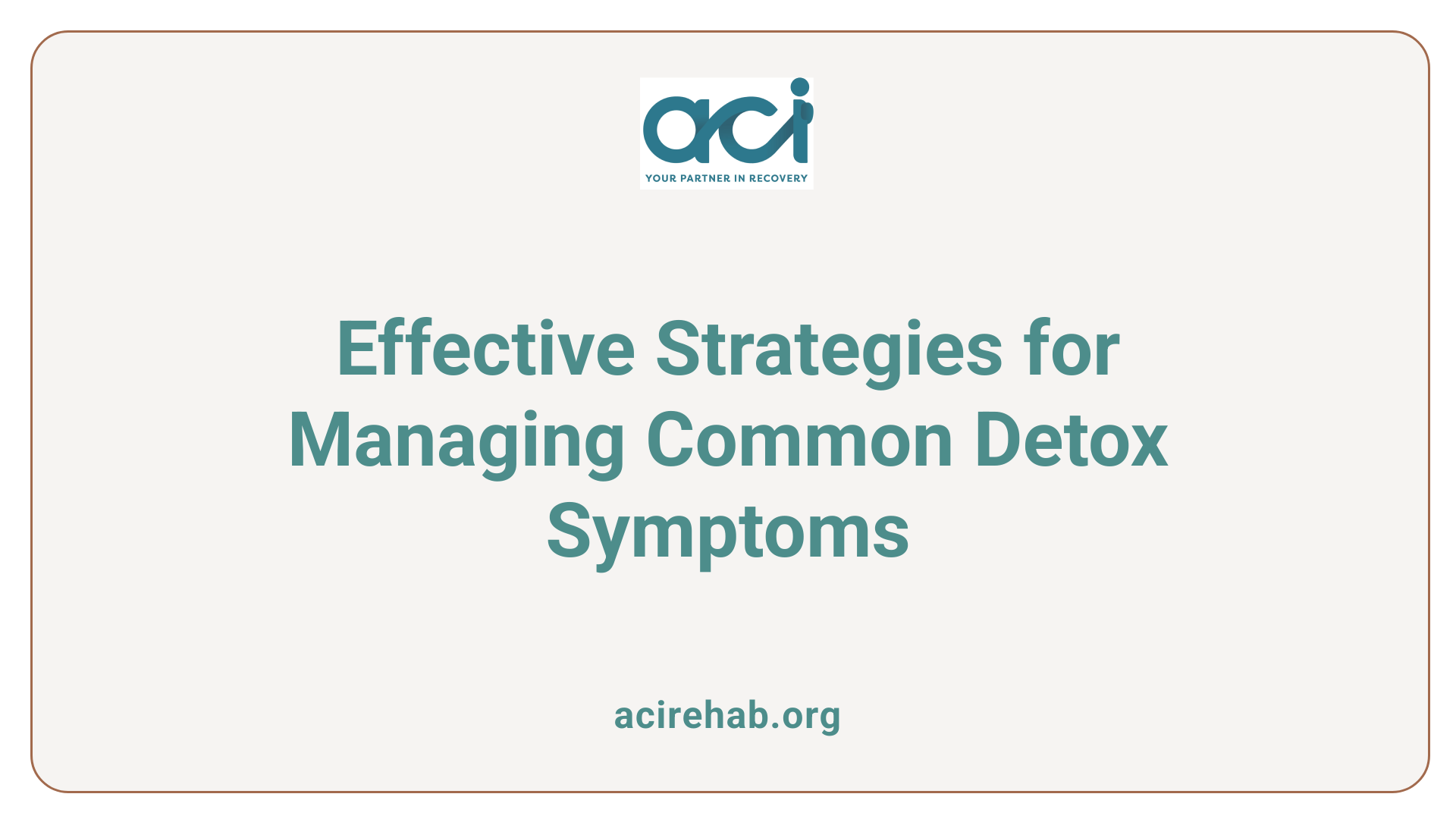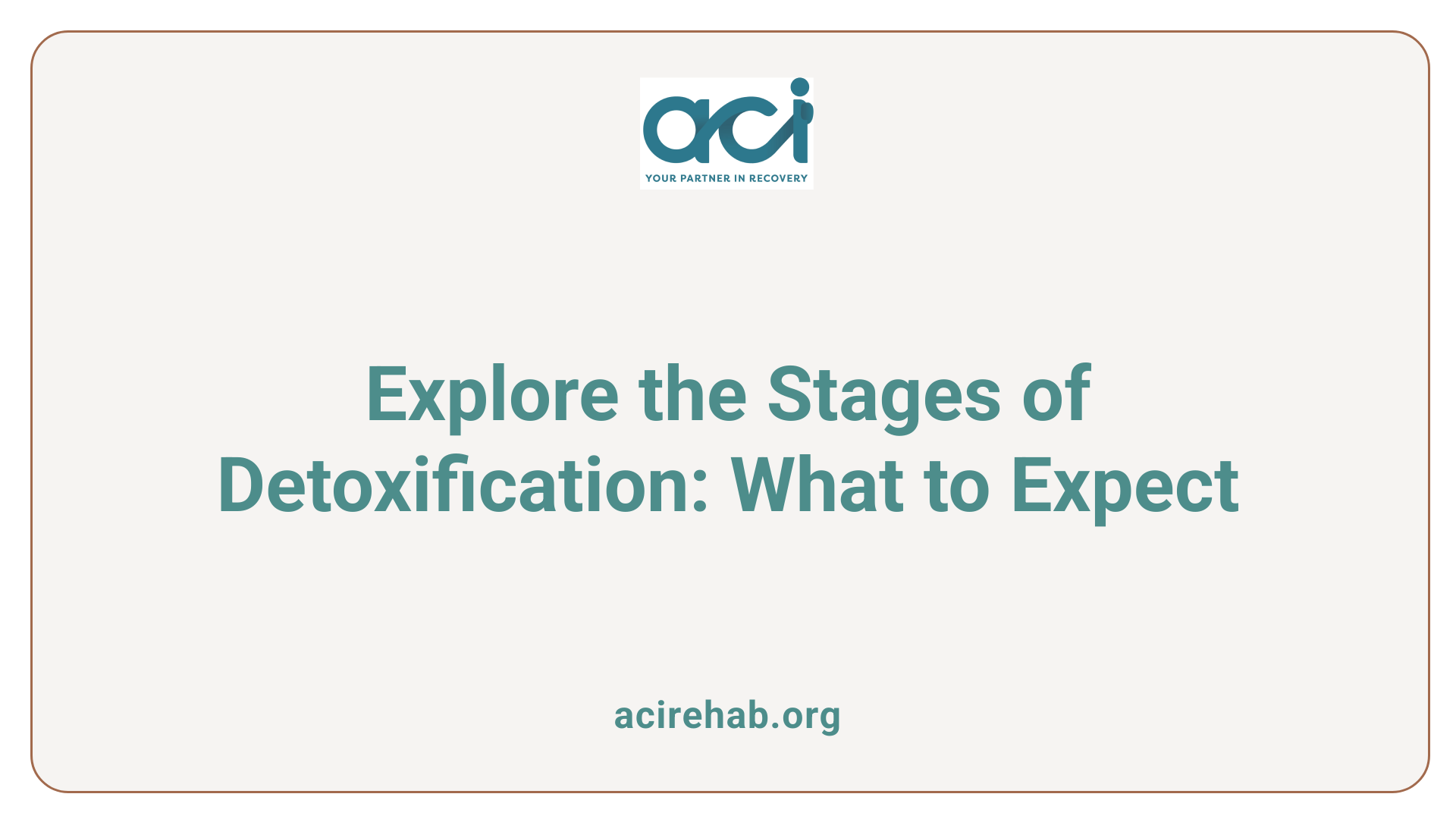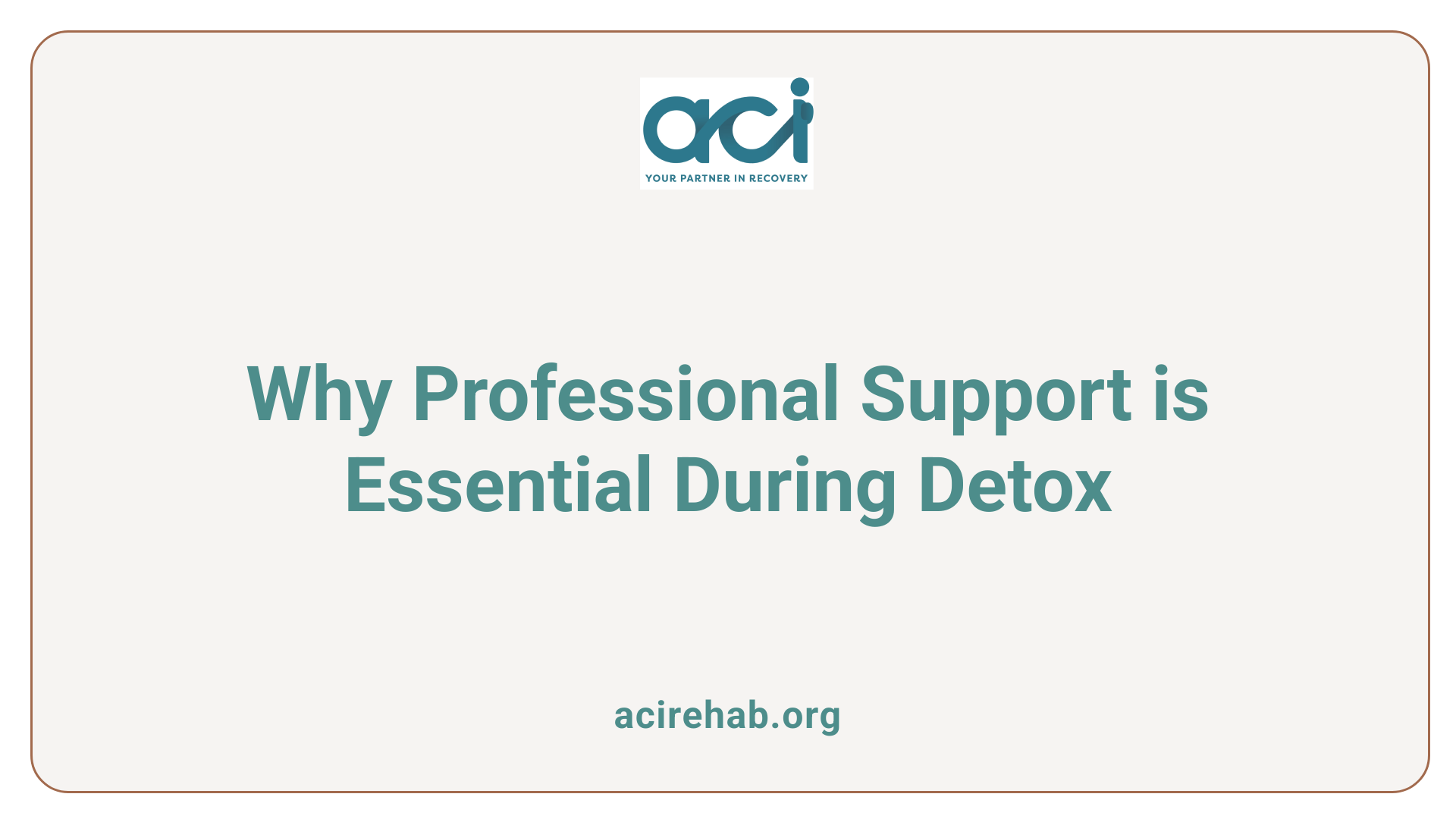Introduction to Detox Symptoms
Detoxification marks a crucial step in the journey to recovery from substance use. Whether it involves alcohol, drugs, or dietary elimination, detox brings about a range of symptoms that can affect individuals both physically and psychologically. Understanding these symptoms and their management is pivotal for anyone undergoing detox or supporting someone through the process. This article explores common detox symptoms, the intricacies of withdrawal, and the importance of seeking professional help to ensure a safe and effective recovery.
Common Symptoms of Detoxification

What are the common symptoms of detoxification?
Detoxification can be a challenging process as the body clears itself of substances, leading to a range of symptoms that vary in severity and duration. Common symptoms experienced during detox typically last from a few days to several weeks. The body responds to the sudden absence of substances by undergoing several physiological changes, which can manifest as:
- Headaches: Often one of the first signs, headaches can range from mild to severe, caused by changes in blood flow and inflammation as the body adjusts.
- Fatigue: As the body works hard to eliminate toxins, individuals often feel mentally and physically exhausted. This typically improves as regular sleep patterns are reestablished post-detox.
- Mood Swings: Emotional instability may arise during detox, with fluctuations attributed to biochemical changes in the brain as it adjusts to the absence of the substance.
- Irritability: Increased irritability is common and often leads to frustration and emotional distress due to withdrawal symptoms.
- Muscle Aches: Muscle pain signals a physiological need for the substance previously consumed, typically subsiding within 2-4 days during detox.
- Difficulty Sleeping: Insomnia is frequently reported, often requiring time to stabilize once the detox process is complete.
- Changes in Bowel Movements: As the digestive system readjusts, individuals may experience alterations in bowel regularity or consistency.
Managing these symptoms is crucial; adequate hydration and nutritious food intake can help alleviate some discomfort. Individuals should consider professional support to effectively navigate the detoxification process.
Physical and Psychological Withdrawal Symptoms

Which withdrawal symptoms can occur during detoxification?
Withdrawal symptoms during detoxification can encompass a variety of both physical and psychological effects. Commonly reported symptoms include:
- Cravings: Often intense, these can arise due to the body’s adjustment to the absence of substances and can be challenging to manage. Talking through cravings and engaging in positive distractions can be beneficial.
- Sleep Problems: Difficulty sleeping is prevalent, often due to the body’s hormonal shifts and the absence of substances previously inducing sedation.
- Headaches: Typically one of the first signs of detox, headaches can range from mild to severe, often linked to inflammation and hydration levels.
- Nausea: As the body readjusts, gastrointestinal disturbances such as nausea and vomiting may occur, reflecting the digestive system’s response to detoxification.
- Irritability: Emotional disturbances, including irritability, can arise as mood swings become common due to the emotional processing challenges faced during detox.
- Mood Changes: Individuals may experience fluctuations in mood, ranging from increased anxiety to depression, necessitating emotional support.
- Restlessness: A feeling of being unsettled may accompany the detox journey, intensifying feelings of anxiety and discomfort.
Additionally, more severe symptoms can manifest based on the substance involved, including confusion or seizures, particularly in cases of alcohol and benzodiazepine withdrawal, underscoring the importance of professional medical support. The duration and intensity of withdrawal symptoms can vary significantly, generally lasting from a few days to several weeks, with cravings potentially persisting longer.
| Symptom | Description | Management Strategies |
|---|---|---|
| Cravings | Intense desire for substances as the body adjusts | Talk it out, stay distracted |
| Sleep Problems | Difficulty achieving restful sleep | Sleep hygiene practices |
| Headaches | Can range in severity, often early sign during detox | Hydration, over-the-counter relief |
| Nausea | Gastrointestinal discomfort common in early detox | Small, light meals, stay hydrated |
| Irritability | Emotional fluctuations that can impact mood | Mindfulness, therapy |
| Mood Changes | Can include anxiety and depression | Professional support |
| Restlessness | Unsettled feeling frequently experienced | Regular physical activity, meditation |
In managing these symptoms, it is imperative to seek professional assistance, ensuring a supportive recovery environment.
Coping with Common Symptoms

Headaches
Headaches are often one of the first signs of detoxification. They can range from mild to severe and are typically caused by dehydration and changes in blood flow. To alleviate headaches, ensure adequate hydration and consider using over-the-counter pain relievers strategically to manage severe pain.
Muscle Pain
Muscle aches are common during detox as the body releases toxins and adjusts to the absence of substances. Generally, this discomfort subsides within 2-4 days. Gentle stretching exercises and warm baths can help ease muscle tension during this phase.
Fatigue
Fatigue is prevalent as the body diverts energy towards elimination of toxins, often leading to feelings of physical and mental exhaustion. To combat fatigue, prioritize rest and establish a consistent sleep routine. Engaging in light physical activity, such as walking, may also enhance energy levels gradually.
Gastrointestinal Distress
Digestive issues like nausea, vomiting, and diarrhea commonly occur during detox. These symptoms result from the body readjusting post-substance use. Staying hydrated is crucial, along with consuming bland, easily digestible foods to soothe the stomach.
| Symptom | Description | Coping Strategy |
|---|---|---|
| Headaches | Ranges from mild to severe | Hydration, OTC pain relievers |
| Muscle Pain | Physical discomfort subsides in 2-4 days | Stretching, warm baths |
| Fatigue | Feelings of exhaustion due to detox efforts | Prioritize rest, light activity |
| Gastrointestinal Distress | Nausea, vomiting, diarrhea | Hydration, bland diet |
Emotional Volatility During Detox
Anxiety
Anxiety is a common psychological effect experienced during detoxification. As substances leave the body, the brain often struggles to adjust, resulting in increased levels of anxiety. Many individuals report severe panic attacks during withdrawal. Managing anxiety typically involves therapies, support groups, and talking through feelings rather than relying solely on medication.
Mood Swings
Emotional instability frequently leads to mood swings during the detox process. A mixture of physical discomfort and psychological changes can contribute to sudden shifts in emotions. These fluctuations may be exacerbated by fatigue and irritability, making it crucial for individuals to engage in self-care and support systems.
Irritability
Irritability is another prevalent symptom as the body adjusts to the absence of substances. Individuals might feel more on edge, leading to conflicts in relationships. Open discussions and mindful practices can be beneficial in managing irritability during this challenging time.
Depression
Depression may also emerge during detox, as brain chemistry shifts without the influence of substances. Symptoms can range from mild sadness to severe depressive episodes. Professional help is often necessary to address these feelings and ensure a safer recovery journey.
The Physical Strain of Detox
Sweating
During detox, the body often undergoes excessive sweating, also known as hyperhidrosis. This process is the body’s natural method of expelling toxins through the skin.
Saunas or regular exercise can further enhance this detoxification through perspiration.
Tremors
Uncontrollable shaking or tremors may occur, particularly as the central nervous system recalibrates after substance suppression. These tremors can be uncomfortable and may also indicate the severity of withdrawal symptoms.
Racing Heart
An increased heart rate is a common physical reaction during detox, reflecting the body’s stress response to substance withdrawal. This can lead to feelings of anxiety and restlessness but often stabilizes as the detox process advances.
Increased Body Odor
Changes in body odor may present during detox as the body works to eliminate accumulated toxins. This change is usually temporary, signifying the cleansing process happening at a physiological level.
| Physical Symptom | Description | Management Techniques |
|---|---|---|
| Excessive Sweating | Body’s method of eliminating toxins through skin | Sauna therapy, stay hydrated |
| Tremors | Uncontrollable shaking due to nervous system change | Calming techniques, hydration |
| Racing Heart | Elevated heart rate linked to withdrawal stress | Deep breathing, relaxation exercises |
| Increased Body Odor | Temporary change in body scent during detox | Regular washing, maintaining hygiene |
The detoxification process brings profound physical changes. Understanding and managing these reactions can pave the way for a smoother recovery journey.
Understanding Drug-Specific Withdrawal
Opioid Withdrawal
Opioid withdrawal symptoms typically emerge within a few hours after the last use and can intensify within the first 72 hours. Common physical symptoms include nausea, vomiting, muscle aches, sweating, and diarrhea. Psychological effects may present as anxiety, irritability, and intense cravings, often leading individuals to struggle with emotional stability during this phase.
Alcohol Withdrawal
Alcohol withdrawal can begin as soon as 6-24 hours after stopping drinking. Symptoms range from mild, such as headaches and anxiety, to severe complications, including hallucinations and seizures. Known as delirium tremens (DTs), these severe symptoms can develop 48-72 hours post-use and require immediate medical intervention. Physical symptoms also include tremors and rapid heart rate, highlighting the physiological impact of alcohol detox.
Cocaine and Methamphetamine Withdrawal
Withdrawal from cocaine or methamphetamine generally results in less severe symptoms compared to alcohol or opioids. However, users may experience fatigue, depressed mood, anxiety, and irritability during detox. Although these symptoms are challenging, they often do not carry the same life-threatening risks associated with more potent substances.
| Substance | Common Symptoms | Severity & Duration |
|---|---|---|
| Opioids | Nausea, vomiting, muscle aches, cravings | Peaks in 72 hours; lasts several days |
| Alcohol | Headaches, hallucinations, seizures | Severe symptoms may begin in 6-24 hours |
| Cocaine/Meth | Fatigue, anxiety, depression | Symptoms vary; generally less severe |
Understanding these symptoms is crucial for managing recovery effectively.
The Stages of Substance Detox

What are the stages of detoxing from substances?
Detoxing from substances often progresses through distinct stages, which can greatly influence the experience of withdrawal. The process begins with the decision to quit and may involve several key phases:
-
Initial Symptoms
- Withdrawal symptoms can start relatively early after substance cessation. For example, those withdrawing from opiates might feel anxiety, muscle aches, or insomnia within 24 hours.
- Physical signs like body pain, fatigue, and cravings are common as the body begins adjusting to the absence of drugs.
- Users may experience digestive disturbances such as nausea and changes in bowel movements during this time.
-
Acute Withdrawal
- Symptoms will often escalate, peaking in intensity around 72 hours after last use.
- This phase can include severe symptoms like headaches, panic attacks, and persistent fatigue, making it essential to have a supportive environment.
- Medication-Assisted Treatment (MAT) using clonidine, methadone, or buprenorphine may be recommended to help manage these symptoms.
-
Post-Acute Withdrawal Syndrome (PAWS)
- Following the acute phase, many individuals may experience PAWS, lasting from several weeks to months. Symptoms can include mood swings, irritability, and intense cravings, indicating the psychological impact of detox.
- It’s crucial during this time to engage in healthy practices and seek professional support, as cravings and emotional disturbances can challenge recovery efforts.
This structured approach to understanding the detox process helps individuals prepare for the challenges ahead, reinforcing the need for support through resources like SAMHSA’s National Helpline.
The Importance of Professional Help

Medical Supervision
Detoxification can be a challenging process due to the range of withdrawal symptoms that individuals may experience. Medical supervision is crucial, especially for those withdrawing from substances like alcohol or opioids, as these can lead to severe complications such as seizures or delirium tremens. Professional healthcare providers can monitor vital signs, administer medications to alleviate withdrawal symptoms, and provide necessary interventions to ensure safety throughout the detox process.
Support Systems
Having a robust support system can make all the difference during detox. Connecting with family, friends, and support groups can provide emotional stability and encouragement. These support systems help individuals feel less isolated, enabling them to share experiences and challenges encountered during recovery. This peer support can reinforce commitment, reduce cravings, and enhance motivation to remain substance-free.
Therapies
In addition to medical supervision and support systems, therapies play a pivotal role in managing the psychological aspects of detoxification. Cognitive-behavioral therapy (CBT) and group therapy are particularly effective in addressing anxiety, mood swings, and emotional distress often experienced during detox. These therapeutic approaches equip individuals with coping strategies, enabling them to tackle cravings and develop healthier habits as they transition to sobriety.
Coping with Psychological Strain
Therapy
Therapy plays a critical role during detoxification. Professionals can provide tools to manage anxiety, panic attacks, and emotional instability, which are common during withdrawal. Cognitive Behavioral Therapy (CBT) is effective for addressing negative thought patterns and coping strategies.
Support Groups
Participating in support groups can significantly alleviate feelings of isolation. Sharing experiences with others on similar recovery journeys fosters understanding and camaraderie. Groups offer a safe space for discussing struggles and successes, minimizing the emotional burden of detox.
Self-Care Strategies
Incorporating self-care strategies is essential. Regular physical activity can help alleviate fatigue and improve mood through endorphin release. Mindfulness exercises, such as meditation or yoga, can reduce anxiety and promote emotional stability. Additionally, staying hydrated and eating nutritious foods aids physical recovery, encouraging mental clarity.
| Strategy | Description | Benefits |
|---|---|---|
| Therapy | Professional guidance for emotional management | Coping skills and emotional resilience |
| Support Groups | Community support for shared experiences | Decreased feelings of isolation and increased support |
| Self-Care Practices | Physical activity, mindfulness, and hydration | Improved mood, reduced anxiety, and overall well-being |
Additional Considerations in Detox
Hydration
Staying hydrated during detox is crucial. The body eliminates toxins through various means including sweat and urine, which necessitates sufficient water intake. Aim for at least 8-10 glasses of water daily, and consider electrolyte drinks to replenish lost minerals.
Nutrition
A balanced diet can significantly impact the detox process. Focus on whole foods rich in fiber, vitamins, and minerals. Foods like fruits, vegetables, and lean proteins support the body’s natural detoxification pathways. Avoid processed foods and high sugar intake as they can exacerbate cravings and mood swings.
Lifestyle Adjustments
Making lifestyle changes can enhance detox outcomes.
- Exercise: Regular physical activity, such as walking or yoga, can boost mood and energy levels.
- Sleep: Establish a consistent sleep routine to help combat fatigue and irritability.
- Mindfulness: Practice relaxation techniques, such as meditation or deep breathing, to manage anxiety.
Addressing these areas fosters a healthier transition during detox and helps mitigate symptoms.
Final Thoughts on Navigating Detox
Detoxification, while challenging, is a vital step in overcoming substance dependency. Understanding the physical and emotional symptoms, seeking professional guidance, and implementing effective coping strategies are all key to a successful detox journey. Whether you are undergoing detox yourself or supporting someone through it, the knowledge and preparation outlined here can help foster a safer and more supportive detox experience. Remember, the path to recovery is personal, and professional support is invaluable in navigating the complexities of detox and withdrawal.
References
- National Helpline for Mental Health, Drug, Alcohol Issues – SAMHSA
- 5 Signs Your Body Is Detoxing | Alpine Recovery Lodge
- What Are the Signs That My Body Is Detoxing? – Conifer Park
- Addiction withdrawal | healthdirect
- Detox symptoms | Signs of drug and alcohol detoxification
- Alcohol Withdrawal: Symptoms, Treatment and Alcohol Detox Duration
- Drug Detox Symptoms | Rise Above Treatment
- What Are the Signs That My Body Is Detoxing? – Elev8 Centers
- Alcohol withdrawal: MedlinePlus Medical Encyclopedia
- 6 Signs Of Toxins Leaving The Body During a Detox

